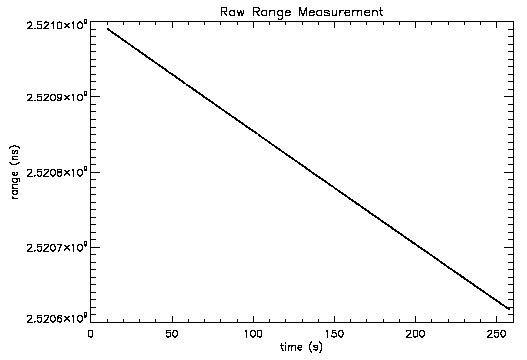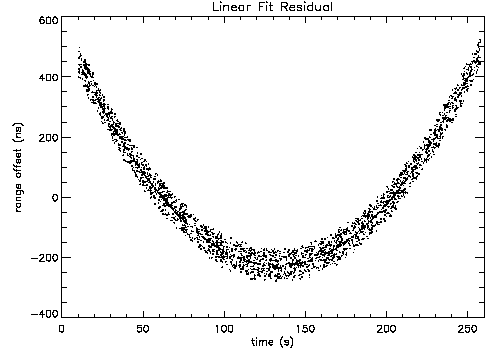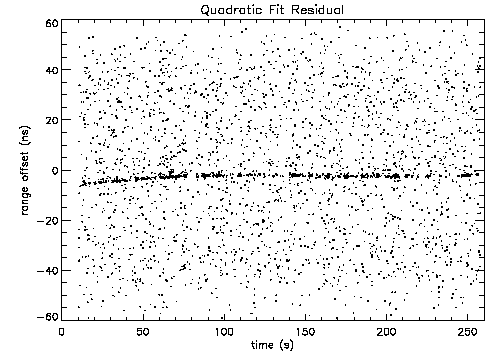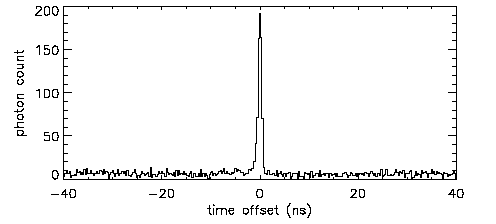The APOLLO apparatus became functionally complete in October 2005 with the inclusion of the microlens (lenslet) array in front of the APD detector. This provides a factor of ten or so gain in sensitivity by eliminating dead space between the elements in the APD array. APOLLO had already benefitted from engineering runs in July, August, and September (see pictures of the beam). Now the apparatus is complete, and we're ready for business.
Early in the morning on October 19, 2005—after a thunderstorm finally cleared—we got two hours on the sky. On the very first four-minute run (5000 shots at 20 shots per second; marked "a" below), we saw a hint of a possible return signal from the (largest) Apollo 15 array.

We changed the timing offset of our apparatus. If we had a real signal, the spike in the time histogram should move accordingly (i.e., follow the dashed line in the plot). It did (b above).
So we changed to a third time offset, in a different direction. The signal came up in the right place (c above), and this time stronger than before. We were absolutely convinced this was real.
We continued to explore, also obtaining an unambiguous range signal from the Apollo 11 array (receiving about 30 photons). By the end of the night, we had collected about 300 return photons from the lunar reflectors over less than two hours. A photon is an individual quantum particle of light—the smallest packet, or lump, of light energy.

The next night (still the 19th), we got on the sky with exceptional "seeing"—or atmospheric image quality. After a brief search, our socks were knocked off by a single 5000-shot run gathering about 420 lunar returns from Apollo 15 (a below).

Over the next half-hour, in five consecutive four-minute runs, we gathered a total of about 2,400 return photons, the most being 700 in a single run (f above). We also saw the Apollo 11 array again.
To put this in perspective, the McDonald Laser Ranging Station (MLRS)—the only other lunar-capable U.S. laser ranging station—gathered about this many photons over the three-year period from 2000–2002. And APOLLO performed this feat very near full moon, where the background is so bright the current lunar ranging stations (in Texas and in France) are not able to work. The only lunar ranges obtained at the full-moon phase in the past 15-plus years have been during lunar eclipses, when the background is much reduced.
We can use the last run above to illustrate a few points and features of the APOLLO lunar acquisition. In the first plot below, we show the range (round trip travel-time) measured by APOLLO during the run labeled "f" above. Here, the measurement—which ranges from 2.34–2.71 seconds depending on wherre the moon is in its orbit—is about 2.52 seconds, which happens to be about average.

The range is constantly changing, since earth and moon are always in relative motion, and—more importantly—earth is rotating at a speed of 400 meters per second at the latitude of the observatory. A rising moon is closing the distance, and a setting moon is getting farther. For this particular run, the observatory is getting closer to the moon by about 222 meters every second.
We only open our detector's eyes for a brief "window", or "gate" around the expected time of our lunar return. We know when the laser pulse left the building, and can therefore predict to few-nanosecond accuracy when to expect the return. A nanosecond is one billionth of a second: light travels about one foot in a nanosecond. We only open our gate for 100 ns around the expected time of arrival. On the scale above, this is 1 four-thousandth of the vertical height of the plot. Thus the gate is never still: in this case we have to move it about 75 ns (almost the full gate width) for every shot, 20 times a second.
The plot above is pretty boring: just a straight line. The scale is too large to see any of the fine detail. So big deal. But if we subtract a straight-line fit from the data, we can suppress the predominant trend and peek at the remainder:

Here we are left with some "curvature", but a few interesting things are visible nonetheless: The 100 nanosecond gate width is now visible as the vertical thickness of the band of dots. These dots are mostly background photons from the bright moon. But these arrive at random times, and fill in the gate uniformly. The laser photons reflecting off of the Apollo arrays, however, come at a very specific time. Namely, they arrive right in the middle of the gate: because we arrange the gate specifically to accomplish this. You can see the thin band of real laser returns threading through the middle of the random fuzz. Now let's get rid of most of the remaining curvature by subtracting the best parabolic fit:

Now we see very clearly the thin streak of lunar return photons embedded in the background of randomly-timed arrivals. The return is somewhat "bursty": it comes and goes. But it is very clearly present. Some residual curvature and offset remain in the data. If we approach the problem differently, using a high-order prediction polynomial from which to subtract the data, we can collapse all of the data into a single histogram:

The lunar returns all fit into a compact spike. The bins above are 250 picoseconds each (a picosecond is a trillionth of a second). The width appears to be roughly 750 ps, which matches the predicted 725 ps width contributed by the large Apollo 15 array at the orientation it had at the time of observation.
A representative datapoint (single time and range measurement) was constructed from the run pictured above, and run by the Jet Propulsion Laboratory (JPL; thanks to Jim Williams, Dale Boggs, and Slava Turyshev) in order to compare the measurement to the model expectation. Though JPL used a "prefit" model lacking proper treatment of some small effects (continental drift, proper coordinate transformations), the agreement was outstanding: 0.17 nanoseconds, translating into one-inch of effective one-way range. This is a great start, but we do not yet have confidence in our telescope coordinates to better than half-a-foot. Many other nanosecond-level effects also must yet be treated. But the close agreement suggests that no large and unanticipated errors exist in this new laser ranging system.
Check out the observing-run highlights page, which summarizes the accomplishments and records we're setting on each of our observing runs.